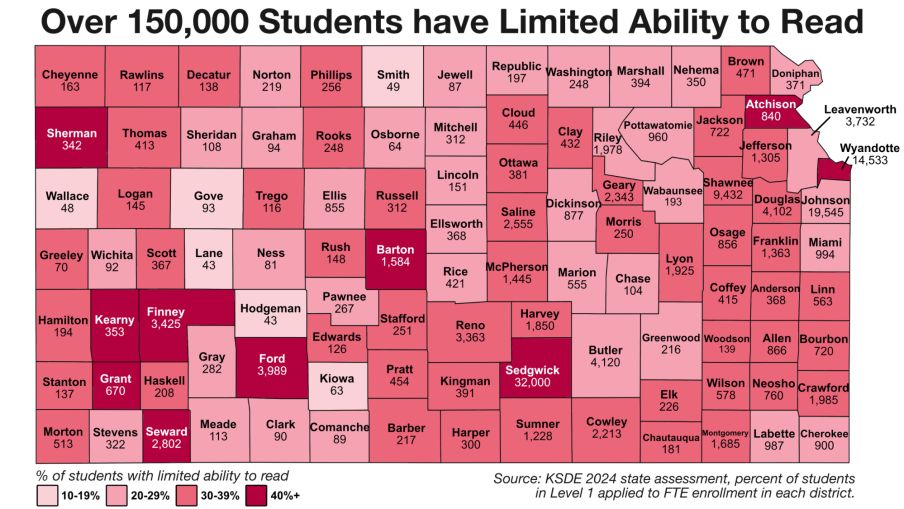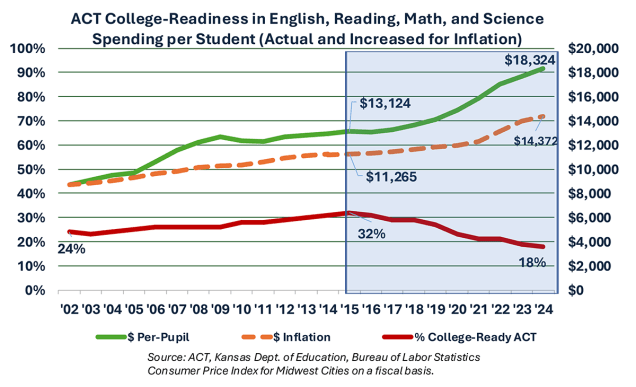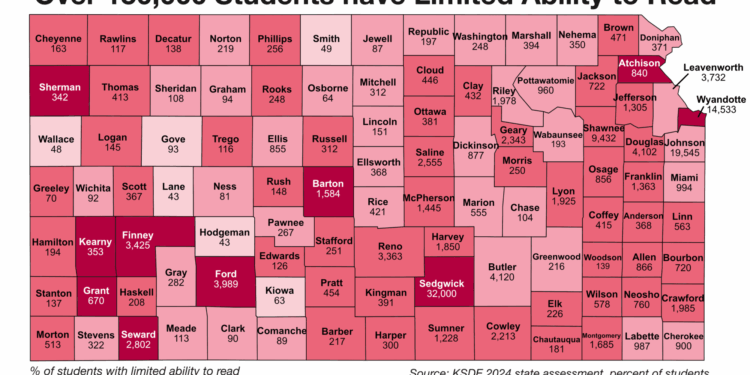Time after time, the Kansas Department of Education and the State Board of Education allow school districts to violate state laws designed to improve student outcomes, and now they’ve shamelessly done it again.
The Legislature passed the Every Child Can Read Act in 2022, requiring literacy to be attained through the Science of Reading, evidence-based reading instruction, and necessary competencies to attain proficiency. KSA 72-3622 requires school districts to report very specific information on or before June 30 of each year:
- The number of third-grade students in the school district,
- The screening and assessment data from at least the preceding two school years that the school district is using as a baseline to evaluate student progress in literacy; and
- The percentage of students who are proficient, moving toward proficiency, or deficient, with percentages provided for all students and student subgroups.
The Legislature passed the Every Child Can Read Act because Kansas has a serious literacy crisis. The map below shows more than 150,000 students have a limited ability to read and may be functionally illiterate.

On August 7, we requested copies of this year’s reports for each district. After weeks of back-and-forth with KSDE General Counsel Scott Gordon, he finally sent some documents on September 18; however, so much information is missing that it raises questions about whether the legally required reports even existed when we first made the request.
Reports for only 229 of the state’s 286 districts were provided, and none of them contained all of the required information.
- Outcomes were reported in Tier 1, Tier 2, and Tier 3 instead of proficient, moving toward proficiency, or deficient, and no definitions were provided for the reported groups.
- Instead of reporting data for at least the preceding school years for all students (the district average) and student sub-groups (low-income, racial categories, etc.), only the district average for the 2024-25 school year was provided.
Districts were required to fill out report templates prepared by KSDE; therefore, much of the blame falls on Commissioner Randy Watson’s team for not requesting all the required information, and for either not knowing or not caring that 67 districts didn’t submit anything.
We asked Gordon to provide the missing information on September 18, but he didn’t respond. We wrote again on September 24 and copied Watson, State Board of Education Chair Cathy Hopkins, and Vice Chair Danny Zeck, but no one responded as of today.
State Board of Education defends the bureaucracy at students’ expense
Parents were hopeful after the 2024 election theoretically gave conservatives a 6-4 majority on the Kansas State Board of Education, thinking that people who campaigned as conservatives would make student-focused decisions rather than defend the system. Unfortunately, students are arguably worse off, as the system-focused board members often prevail. For example, the new board knows school districts violate state laws requiring over $500 million of targeted funding be spent on “above and beyond” services for students who are academically at risk, but won’t take action to help students.
Most recently, the board voted 7-3 to dumb down proficiency standards to make the system look better with higher achievement levels, with State Board of Education members Dombrosky, O’Brien, and Potter dissenting. They bought KSDE’s claim that they didn’t reduce rigor, while expecting Kansans to believe 8th-grade reading proficiency jumped from 22% last year to 46%. That’s like trying to convince someone it’s raining when your dog is whizzing on their boots.
ACT and the National Assessment of Educational Progress (NAEP) show Kansas’ steady outcome declines, as did the state assessment before the State Board of Education reduced standards. College readiness in English, Reading, Math, and Science declined from 32% in 2015 to just 18% now. NAEP says Kansas has more students who are likely functionally illiterate (Below Basic) than proficient.

And rather than doing something about the achievement crisis, state education officials ignore state literacy laws and try to make themselves look good with lower standards.
It’s now up to legislators to decide whether Kansas students will be academically prepared for life after high school by stripping accreditation from districts that don’t follow state laws or show academic improvement, reinstating high proficiency standards, and allowing parents to send their children to schools that best fit their needs.
Legislators know there is OVERWHELMING bipartisan voter support for these principles. Whether enough of them have the gumption to risk re-election by challenging the education bureaucracy is the question.










